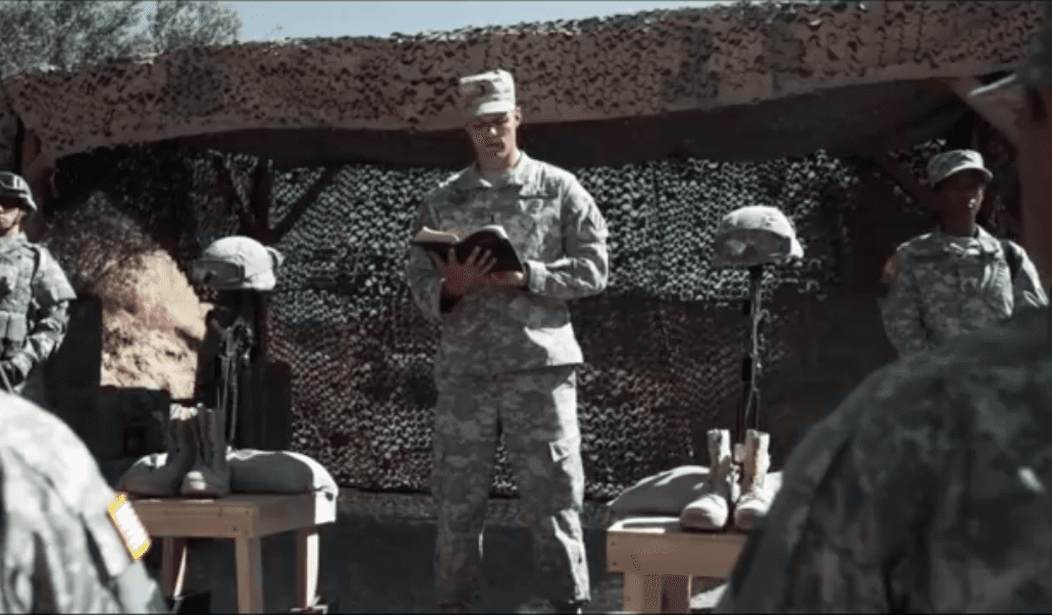There are thousands of military chaplains serving the armed forces. One of the most famous is Darren Turner, whose true story of marital difficulties after a 15-month deployment to Iraq is the basis for the new movie “Indivisible.”
I interviewed Turner over the summer for The Stream after watching a pre-screening of “Indivisible.” At the screening, Turner told chaplains and media in attendance that the movie took several significant liberties in order to make the film more appealing to its target audiences — military servicemembers and their families, especially chaplains.
“Indivisible” is a fantastic movie which gets a 5/5 ranking. It is a must-see for military families as well as civilian families who want to understand what servicemembers and their loved ones go through during deployments. Its portrayal of the difficulties faced by those left at home during deployments is especially excellently done, through both the overall storyline and by timing Turner’s family’s hardships to those which the chaplain faced in war.
Four Families
Turner’s family stars in the movie, but three other families make up the primary supporting cast. There is the neighboring father and husband who uses alcohol to anesthetize himself from the scars of war. There is the young man whose wife is pregnant with their child, and the single mother whose three-year old son is the center of her life.
Turner is their chaplain, but three of the families become friends. The alcoholic’s wife and Turner’s wife lead domestic efforts for Christmas gifts for the troops, consoling family members who lose loved ones during the deployment and helping the pregnant mother after her husband dies overseas.
Turner also helps the deployed servicemembers connect with their families. The single mother is able to send a video to her son and mother. The alcoholic loses his leg in the deployment, but comes home a better man, husband, and father. And the deceased husband – Lance – dies with a smile on his face, confident in God’s grace because of Turner’s chaplaincy.
Tough Times for Turner’s Family
One of the best series of scenes shows Turner on patrol with a squad that gets ambushed. Simultaneously, his wife is dealing with their daughter’s allergy attack from the hay at a corn maze. As Turner’s wife rushes their daughter to the hospital, scared because she’s not breathing, Turner is scared for his own life and that of the squad.
The phone conversation the Turners have after these scary moments are over is the first scene showing familial tension. Turner says he had a long day — hence his impatience — and his wife can’t understand why he’s being insensitive. Shortly thereafter, Turner forgets to look at daily updates from his wife on a website she made for them, so she stops putting them up.
Throughout the deployment, Turner takes notes about his experience – but never tells his wife about them. The movie captures this facet of this deployment well, showing that in trying to protect his family, Turner is really shutting them out.
When Turner returns home, he is a changed man. He’s paranoid, short-tempered, and focused on himself. He snaps at his kids and his wife, scaring them and forcing his wife to tell him he’s no longer welcome in the home.
The chaplain’s turning point begins when he sits down with his chaplain superior. Turner says God should have protected the solders who died and were injured. His superior’s response reveals that Turner presumptuously thought God’s will was his own.
That same chaplain superior provides marital counseling for Turner. Finally opening up, Turner explains that he was trying to protect his family from his suffering, and from the shame of his anger and lack of faith. He provides his wife with his video and text journals, which she reads with difficulty but increased understanding of what he went through while deployed.
The journey isn’t over, though. It is Turner’s neighbor and fellow servicemember — a man now with one leg but a newly-discovered relationship with his daughters and wife — who shows Turner the error of his ways. “I’m back, but my neighbor’s gone,” he tells Turner. When Turner says he failed Lance, the neighbor explains that Lance died confident in God because of Turner.
As Turner makes his final transition back to a family man, the song “It Ain’t Over Yet” is the perfect backdrop for the hard work he puts in. As he and his family make the decision for him to accept another deployment, ready this time for the difficulties and joys inherent in it, the movie ends with a powerful graveyard scene with Lance’s family.
Artistic License
As mentioned above, the real Turner and his wife spoke at the pre-screening which I attended. They said the movie took artistic license with several key components of the movie. Those licenses are described below:
- The movie portrays Turner as having classic paranoid and depressive PTSD. However, this was not what afflicted the real Turner. As described in both his presentation and in his interview with me, his actual problems were self-inflicted — selfishness, anger, and a desire to shut himself off from his family. Turner said that the changes were made in the movie so that it could more broadly appeal to military families.
- The scene in which Turner is kicked out of his house includes Turner yelling at his children and taking his journal from them. This incident did not happen, but in the movie it is part of a series of scenes which excellently portray how Turner’s family life fell apart.
- The scene swaps where Turner is dealing with an ambush and his wife is dealing with the near-death allergy attack by their daughter were brilliantly conceived and executed. However, those incidents did not happen at the same time.
- The three people with whom Turner develops close relationships in the movie – the neighbor, the single mother, and Lance – were a composite of what Turner described as approximately 15 people with whom he interacted with during his deployment.
These artistic licenses did not take away from the high-quality nature of “Indivisible.” First, they helped make a great movie. Second, as Turner noted, you can’t develop 15 people’s backgrounds and relationships in a two-hour movie. Lastly, while chaplains are the primary audience of “Indivisible,” the changes made regarding Turner’s relationship with his family will bring far wider appeal because – as Turner noted – many servicemembers suffer from PTSD and other issues which are portrayed in the movie.









Join the conversation as a VIP Member